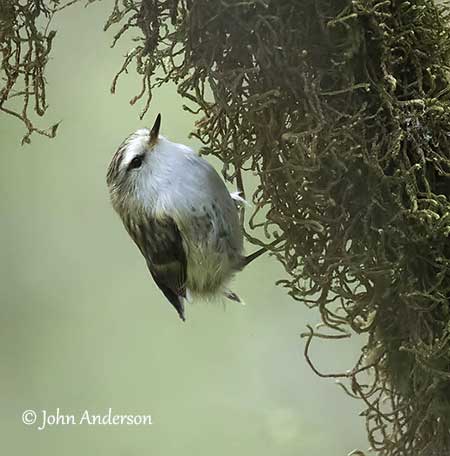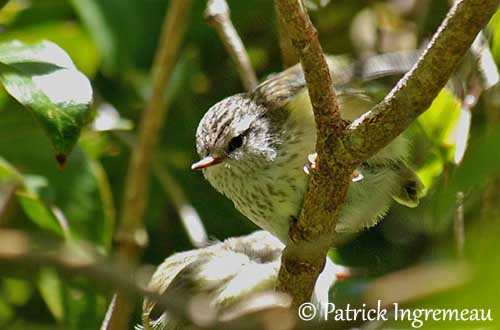
Fr: Xénique grimpeur
Maori: Titipounamu
Ang: Rifleman
All: Grünschlüpfer
Esp: Acantisita Verdoso
Ita: Acantisitta verde
Nd: Geweervogel
Sd: Klättersmyg
Photographers:
John Anderson
John Anderson Photo Galleries
Patrick Ingremeau
TAMANDUA
Illustrator:
William Lawry Buller (1838-1906)
« A History of the Birds of New Zealand, 2nd Edition »
Text by Nicole Bouglouan
Sources:
HANDBOOK OF THE BIRDS OF THE WORLD Vol 9 - by Josep del Hoyo - Andrew Elliot - David Christie - Lynx Edicions - ISBN: 8487334695
KNOW YOUR NEW ZEALAND BIRDS by Lynnette Moon - New Holland Publishers – ISBN: 1869660897
BirdLife International (BirdLife International)
New Zealand birds and birding (Narena Olliver)
New Zealand bird status between 2008 and 2012
Te Ara – The Encyclopedia of New Zealand
Tiritiri Matangi Open Sanctuary
Wikipedia, the free encyclopaedia
Page Family Acanthisittidae
Page Passeriformes Order
DESCRIPTION OF THE BIRD:
Biometrics:
Length: 7-9 cm
Weight: M: 6 g – F: 7 g
The adult male has bright green upperparts with yellow-green rump. On the folded wings, there are green, black and white patches, and a transverse yellow band at bases of the flight feathers, forming a pale wingbar conspicuous in flight. The short tail is blackish with whitish tip.
On the underparts, chin, throat, breast and belly are white with variable yellowish wash. Flanks are mostly yellowish.
On the head, we can see a pale to whitish supercilium, and the ear-coverts are brownish.
The slender, slightly upturned bill is dark brown or black. Some birds may have yellow base of lower mandible. The eyes are dark brown with white half eyering below the eye. Legs and feet are brown to orange-yellow with yellow soles.
The female is slightly larger than male and she has duller plumage with yellow-brown streaked dark upperparts, and yellow-brown rump. The underparts are pale grey.
The juvenile resembles female but it has streaked breast and upperparts, and indistinct supercilium. Some birds can be more extensively spotted and streaked.

SUBSPECIES AND RANGE:
The Rifleman has two subspecies:
A.c. chloris (here described) is widespread throughout western South Island, and occurs on Banks Peninsula and in Kaikoura area. The species is surviving on Codfish Island, but recently extinct on Stewart Island.
A.c. granti (immature here displayed) is found in patchy distribution on North Island and throughout the eastern ranges. Some remnant populations occur in Northland, on Little Barrier Island and in Mont Egmont National Park.
This race has less yellow wash on underparts and flanks.
HABITAT:
The Rifleman frequents beech forest and scrub, and pine plantations with thick native shrubs. It can be seen sometimes in open areas in hedgerows, gorse and bloom patches, both are introduced plants to New Zealand. It is manly found above 400 metres and up to 1500 metres of elevation.
CALLS AND SONGS: SOUNDS BY XENO-CANTO
The Rifleman utters rapid, high-pitched “tsit-tsit” calls, given by both sexes. If threatened, it produces a rapid, high frequency decrescendo sound. While foraging, the birds utter contact calls almost continuously. The high frequency of the calls is often inaudible to humans.

BEHAVIOUR IN THE WILD:
The Rifleman is an insect eater. While foraging and feeding, the bird is always moving and clinging on tree bark. It forages among the foliage by spiralling upwards from the tree base. It flutters around trunks and branches, and probes into moss and bark with its upturned bill. Once at tree top, it drops down and starts foraging on the next tree in the same way.
It hangs upside-down to glean in crevices, and appears active while feeding and is constantly flicking its wings.
It usually takes insects and their larvae, spiders, moths and beetles. It may occasionally take ripe fruit but it rarely feeds on the ground. However, it can be seen feeding in lower canopy and nearby shrubs.
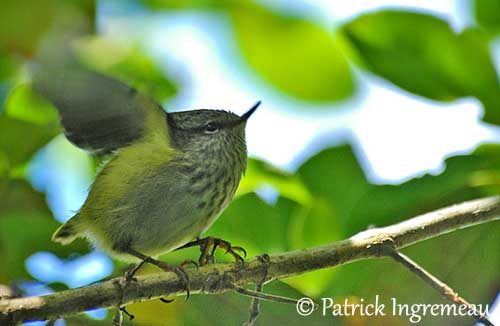
Pairs have permanent pair-bonds and the adults remain in their home range all the year. They are regarded as territorial although territorial behaviour, fighting and singing are very rare.
The Rifleman breeds in the first year of its life, usually at 9 months old.
The courtship displays are very simple. The male remains in close proximity of the female before the egg laying, probably to guard her from extra-pair copulations. Courtship feeding is reported during the egg laying.
Helpers are present during the nesting period. They feed the chicks and defend them, and remove the faecal sacs. During the first brood, helpers are often unpaired adult males, whereas during the second brood, they are juveniles from the first brood.
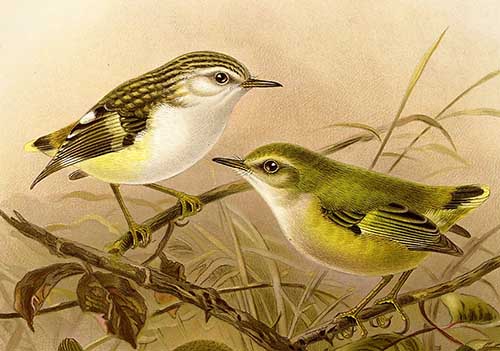
REPRODUCTION OF THIS SPECIES:
The breeding season takes place between August and February and mainly from September to November.
The enclosed, spherical nest is usually built in small cavities in trees or under bark, among rocks or in crevices in cliffs. The nest is made with woven dry grass, twigs, moss and rootlets. Inside the nest, the lining is made with soft grasses and feathers.
The female lays 2-5 white eggs and both adults incubate during 20 days. The chicks are fed by parents, and from the 5th day, also by helpers. They leave the nest about 24 days after hatching, and are independent by 4-6 weeks.
This species usually produces two broods per season.
PROTECTION / THREATS / STATUS:
The Rifleman’s population is currently declining and fragmented, due to habitat clearance and predation by introduced pests, and especially stoats.
The species is locally common or widespread according to the area in North and South Islands. The numbers are unknown.
The Rifleman has large range and numbers are increasing in areas where predators have been controlled. It is currently evaluated as Least Concern.
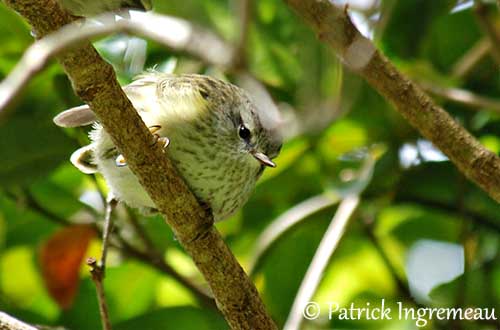
PAIR
Female on the left
Male on the right
William Lawry Buller (1838-1906)
The Rifleman adult occupies its home range all year round. However, the juveniles disperse only short distances from their natal territory to a close suitable area of forest.
The moult occurs from late January and lasts 50-60 days, until early April.
The Rifleman has short, rounded wings with reduced wing skeleton. From several observations, the extinct New Zealand wren species were flightless in the absence of mammalian predators. The Rifleman is very often seen moving along tree trunks and branches. It only uses short flights from canopy to canopy and performs fast wingbeats.
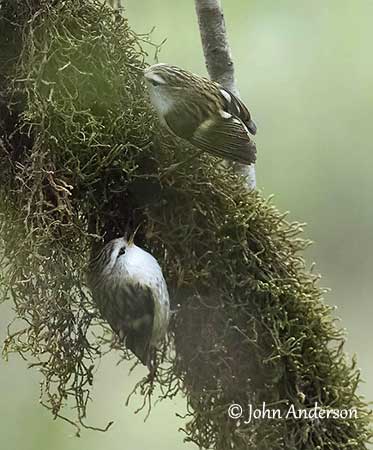
Rifleman
Acanthisitta chloris
Passeriformes Order – Acanthisittidae Family
INTRODUCTION:
The Rifleman is one of the smallest songbirds of New Zealand, a small insect-eater endemic to this country. The family Acanthisittidae is that of the New Zealand wrens, and only two species are surviving today.
Male and female have different plumage adapted to their feeding areas. Both mates forage together outside the breeding season, but when they are feeding the chicks, the male forages from foliage and its green plumage provides it a good camouflage, whereas the female forages mostly from tree trunks and her browner plumage makes her very cryptic in such environment.
